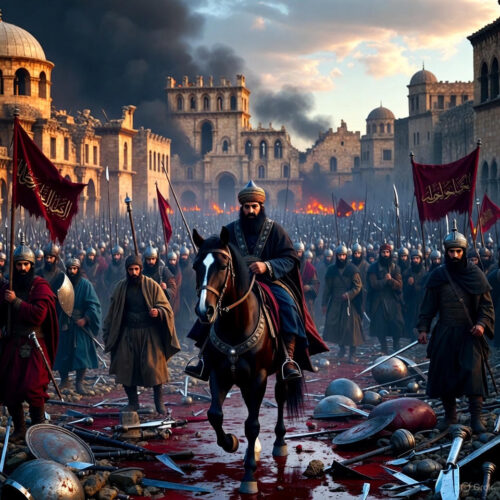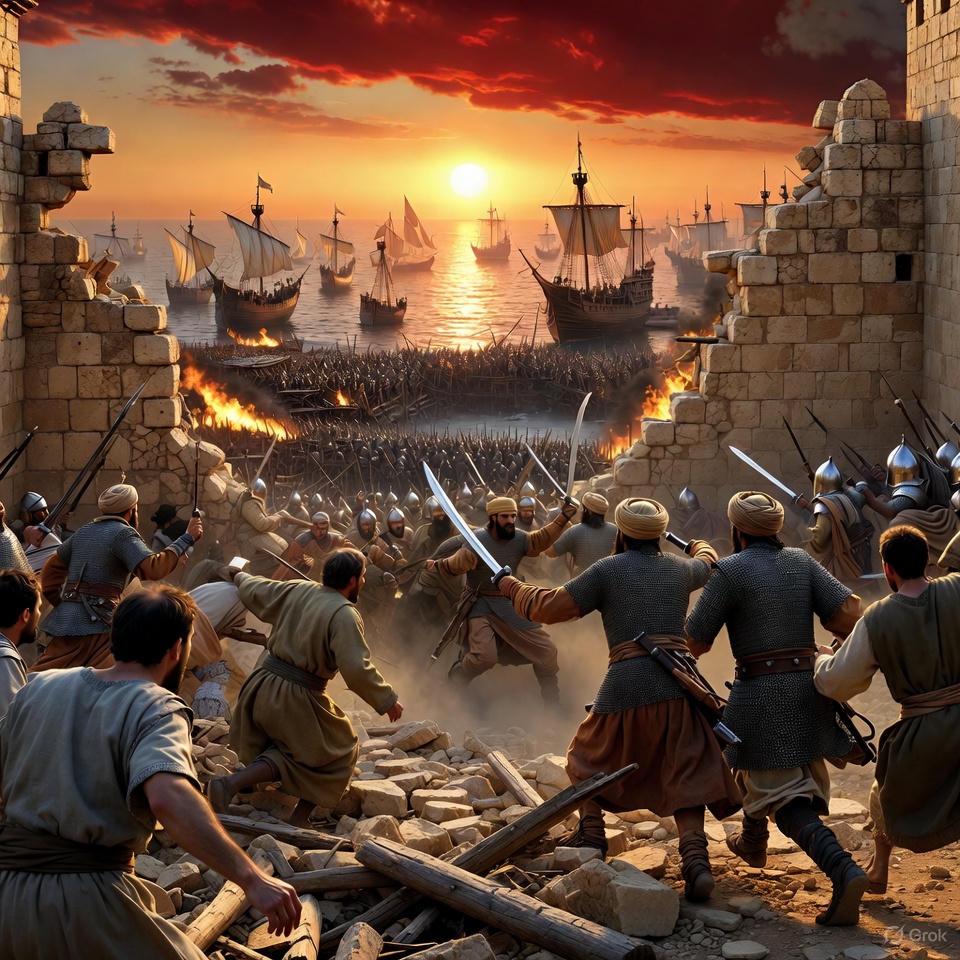Imagine a city perched on the edge of the world, where the Mediterranean’s azure waves lap against walls scarred by two centuries of holy wars. It’s spring 1291, and the air hums with the creak of massive wooden wheels hauling siege engines the size of cathedrals. Acre—ancient Ptolemais, jewel of the Levant—is no mere fortress; it’s the throbbing heart of Christendom’s fading dream in the Holy Land. For 192 years, since the First Crusade’s triumphant march in 1099, European knights in gleaming mail had clung to slivers of this sun-baked coast like barnacles to a storm-tossed hull. Jerusalem had fallen in 1187 to the indomitable Saladin, but Acre endured, a defiant beacon for pilgrims, merchants, and warriors alike. Its double walls, ringed by moats and towers, sheltered a polyglot throng: French knights, Italian traders, Genoese sailors, and Teutonic burghers, all under the fluttering banners of the Templars’ red cross and the Hospitallers’ white eight-pointed star.
But on April 6, 1291, the horizon darkened. From the south marched the Mamluk horde, an army so vast it uncoiled like a serpent across the dunes—over 100,000 infantry, 20,000 cavalry, and engineers whose catapults could hurl 300-pound stones farther than a longbow’s arrow flies. At their head rode Sultan al-Ashraf Khalil, a 31-year-old lion of a man, his armor etched with Quranic verses, his eyes burning with the fire of unfinished vengeance. His father, Qalawun, had sworn to erase the Frankish stain from Syria, but death claimed him on November 10, 1290—ironically, the very date we mark today in 2025—leaving Khalil to inherit not just a throne, but a crusade of his own. This was no skirmish; it was the death knell for an era. The Siege of Acre would rage for six weeks, a symphony of stone shattering against stone, blood soaking the sands, and desperate cries echoing to the stars. By its end on May 18, the last Crusader foothold in the Holy Land would crumble, sending shockwaves through Europe that reshaped history. Yet in its ashes lies a tale not just of defeat, but of unyielding human spirit—a blueprint for fortifying the battles we fight today in the quiet sieges of our own lives.
To grasp the magnitude of Acre’s fall, we must wind back the clock through the labyrinthine corridors of the Crusades, that audacious medieval experiment where faith, greed, and glory collided like tectonic plates. It began in 1095 when Pope Urban II, standing in a muddy field at Clermont, thundered to a crowd of feverish nobles: “God wills it!” His call to reclaim Jerusalem from Muslim hands ignited the First Crusade, a ragtag exodus of 60,000 souls—kings, peasants, monks, and mercenaries—who braved deserts, mountains, and ambushes to storm the Holy City in 1099. Rivers of blood ran in the streets that day; chronicler Raymond d’Aguilers wrote of “horses wading in blood up to their knees.” The Crusaders carved out kingdoms: the County of Edessa, Principality of Antioch, County of Tripoli, and the Kingdom of Jerusalem itself, a fragile lattice of Latin fiefdoms strung along the coast like beads on a rosary.
These were no idle outposts. Acre, captured in 1104 after a brutal five-year siege by Baldwin I, blossomed into a cosmopolitan nexus. By the 13th century, its harbors teemed with galleys from Venice and Pisa, laden with silks from Cathay, spices from India, and timber from the Black Forest. The city sprawled over 100 acres (a fitting name, from the Hebrew “Akko,” meaning sand dune), divided into an inner walled citadel and an outer suburb called Montmusard, where vineyards and orchards softened the martial skyline. Eight orders of friars—Dominicans, Franciscans, and more—preached in its churches, while the military orders, born of necessity, guarded the gates. The Knights Templar, founded in 1119 as nine French knights vowing to protect pilgrims, had evolved into a banking empire, their white mantles with red crosses fluttering over commanderies from Paris to Cyprus. Beside them stood the Knights Hospitaller, healers turned holy warriors, their black-and-white habits a stark emblem of mercy amid mayhem.
But glory faded fast. The Second Crusade (1147-1149), led by Louis VII of France and Conrad III of Germany, fizzled in a humiliating retreat from Damascus. The Third, sparked by Saladin’s 1187 triumph at Hattin—where he lured the Crusader army into a waterless trap and beheaded Reynald de Châtillon on the spot—culminated in Richard the Lionheart’s 1191 conquest of Acre. Richard, that swashbuckling Plantagenet, arrived with 25 ships and 33,000 men, bombarding the city for two months until Saladin’s garrison surrendered. Yet even he couldn’t retake Jerusalem; a truce left Acre as the Crusader capital, a consolation prize gleaming under the Palestinian sun.
The 13th century brought flickering hopes and crushing blows. The Fourth Crusade veered disastrously into sacking Christian Constantinople in 1204, enriching Venice but alienating Byzantium. The Fifth (1217-1221) targeted Egypt but bogged down in the Nile Delta. Frederick II, the “Stupor Mundi” (Wonder of the World), briefly reclaimed Jerusalem in 1229 through diplomacy, not swords, but his excommunication soured the victory. Then came Louis IX of France’s Seventh Crusade (1248-1254), a gilded fiasco ending in his capture at Mansurah, where he ransomed himself with 800,000 bezants and the promise of Demotika’s fortifications. Released, Louis fortified Acre, doubling its walls and moats, a legacy that would soon be tested.
Enter the Mamluks, the slave-soldiers turned sultans who seized Egypt in 1250 from the Ayyubids. Recruited as Circassian boys from the steppes, trained in the brutal art of mounted archery and swordplay, they were loyalty forged in iron. Qalawun, ascending in 1279 after a coup, eyed the Franks not as infidels alone, but as economic parasites—Christian merchants undercutting Muslim trade with tax-free ports. In 1289, he razed Tripoli after its citizens massacred Muslim envoys, a blood-soaked prelude. Chronicler Ibn Shaddad noted Qalawun’s vow: “I shall not rest until every Frankish head is severed.” Preparations for Acre began: vast mangonels (catapults) assembled in Cairo, their ropes twisted from Sicilian hemp, their counterweights stuffed with sandbags. But on November 10, 1290—today’s echo in history—Qalawun succumbed to fever in Damascus, his body embalmed in quicklime and borne home. His son Khalil, hardened by purges and plots, inherited the mantle, declaring, “The Franks shall perish root and branch.”
Word reached Acre like a chill wind off the sea. Guillaume de Beaujeu, the Templar Grand Master since 1275, a grizzled veteran of Arsuf and Homs, dispatched spies. One, the emir al-Fakhri, whispered of the storm brewing. Beaujeu urged evacuation—women, children, the infirm to Cyprus—but the commune, a fractious council of Italian podestàs and Pisan consuls, scoffed. “We are lions, not lambs,” boasted the Genoese admiral. Beaujeu, ever pragmatic, fortified the Templar tower on the northeast wall, a squat bastion called the “Pilgrim’s Castle,” while the Hospitallers manned the southwest under Jean de Villiers. King Henry II of Jerusalem and Cyprus arrived in March with 400 knights, a token force. Total defenders: perhaps 1,000 heavy cavalry, 6,000 infantry, and 15,000 souls—merchants, pilgrims, prostitutes—huddled within.
Khalil’s host arrived on April 5, encamping from the cursed stream of Belon to the sea, a two-mile crescent of tents shimmering like a mirage. The sultan’s red pavilion, the *dihliz*, rose on a hillock opposite the legate’s tower, a silk marquee where emirs plotted by lamplight. By dawn April 6, the barrage began. “Victorious,” a mangonel 20 feet tall, lobbed boulders that arced like vengeful comets, splintering ramparts and crushing unfortunates in their beds. “Furious” targeted Montmusard, igniting thatched roofs with naphtha pots that bloomed into greasy fireballs. Smaller “Black Oxen” mangonels, nimble as assassins, picked off sentries with unnerving precision. Muslim sappers, veiled in wicker screens, tunneled beneath the walls, their picks muffled by chants of “Allahu Akbar.” Crusader counter-mines exploded in retaliation, burying diggers alive in choking dust.
The first sortie came April 15: 500 Templars and Hospitallers, lances couched, thundered from the Accursed Gate, skewering Mamluk pickets and setting fire to siege towers. Beaujeu led the charge, his white beard streaming, sword felling three foes before trumpets recalled them. Khalil, unmoved, redoubled the rain of stone—over 100,000 projectiles in the first week, per Templar rolls. Inside, famine gnawed; wheat rose to 100 bezants a bushel, cats to 20 shillings. Pilgrims pawned relics for bread; one English knight bartered his chainmail for a loaf. Yet morale held, buoyed by sea relief: Venetian convoys slipped in under cover of “The Burning Galley,” a fireship that once torched an Egyptian squadron.
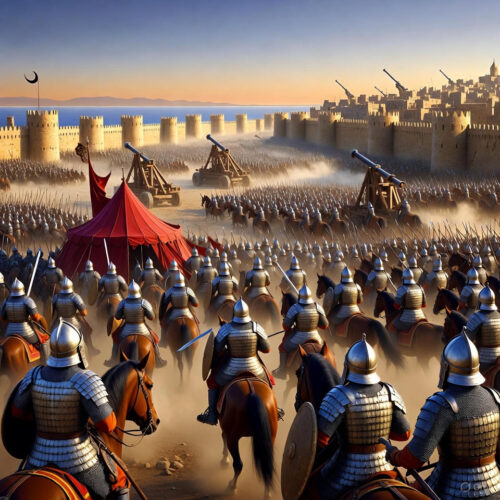
May brought desperation. On May 4, a colossal assault: 2,000 Bedouin archers screened infantry waves crashing against the walls like breakers. Ladders hooked over crenellations; grappling irons bit stone. From the battlements, Genoese crossbowmen loosed bolts thick as reeds, felling climbers mid-scramble. The Teutonic Knights, black crosses stark against the sky, hurled Greek fire—pots of pitch and sulfur that erupted in adhesive infernos, roasting attackers alive. Their screams mingled with the twang of bowstrings and the thud of bodies plummeting into the moat. One Hospitaller, Brother Gerard, chronicled: “The air was thick with arrows, a forest of death; men fought as if Judgment Day had dawned.” The assault broke, leaving 4,000 Mamluk dead, but the walls sagged, cracks spiderwebbing like veins.
Khalil, a tactician schooled in Mongol stratagems, shifted to guile. Sappers mined the Templar tower, propping tunnels with timber laced in pitch. On May 15, they fired the supports; the ground trembled as if Leviathan stirred. A 100-foot section of wall collapsed in a roar of rubble, burying French knights in their posts. Mamluks poured through the breach—fierce Bahri cavalry in silk turbans, scimitars flashing—slaughtering all in reach. Beaujeu, atop his destrier, rallied a countercharge: “For Christ and the Temple!” His blade carved a red arc through the melee, but a lance pierced his gorget; he toppled, gurgling, into the dust. The Templars fought on, a phalanx of steel, until the king ordered retreat. Montmusard fell next, its suburbs a pyre of looted villas.
The end came May 18. As dawn gilded the waves, another mine detonated under the Accursed Tower. Walls buckled; the Hospitaller bastion tilted like a drunkard. Mamluks swarmed, 10,000 strong, axes hewing at barricades of wagons and pews. Inside, chaos reigned: nobles in velvet doublets clambered over corpses, mothers clutched babes amid the crush. The gates to the harbor jammed with fugitives; overloaded cogs capsized, drowning hundreds in the surf. One eyewitness, the Armenian chronicler Hayton of Corycus, described “a sea of blood, where the waves broke red upon the shore.” King Henry escaped on a Pisan galley, but thousands did not—estimates vary wildly: 7,000 slain in the streets, 30,000 captured and enslaved, sold in Damascus markets for a dirham apiece. The Templars’ last stand was mythic; survivors claimed 200 brothers perished in the breach, their bodies heaped like cordwood.
Acre’s sack was biblical in savagery. Mamluk troops, fueled by tales of Tripoli’s perfidy, spared none: knights beheaded on altars, nuns violated in convents, children trampled under hooves. The Great Mosque, once St. Andrew’s Cathedral, ran with gore; its bells melted in the blaze. Khalil entered triumphant, his boots grinding Crusader spurs into powder, but even he blanched at the carnage—chroniclers note he wept for the desecration of holy sites. By June, Tyre yielded without fight, its governor fleeing by sea. Sidon held briefly, its Templar commander, Eschiva d’Ibelin, bargaining surrender for safe passage. Beirut fell July 21, its walls toppled by mines. Athlit Castle, the Templars’ “Pilgrim,” evacuated August 14, its garrison sailing into legend. The Levant was cleansed of Franks; the Crusader states, born in fire, expired in ash.
The ripples spread like ink in water. In Europe, Acre’s fall stunned the courts. Pope Nicholas IV wailed in a 1291 bull: “The lamp of the Lord is quenched in Jerusalem!” Calls for an Eighth Crusade echoed—from England’s Edward I to France’s Philip IV—but apathy reigned. The Black Death loomed, Mongol khans distracted, and trade routes shifted to the Atlantic. The military orders, bereft of purpose, turned inward: Templars to Cyprus, then persecution in 1307; Hospitallers to Rhodes, birthing the Knights of Malta. Intellectually, it birthed the Renaissance’s pivot: scholars fleeing with Arabic manuscripts—Avicenna’s medicine, Ptolemy’s stars—fertilizing Europe’s soil. Politically, it emboldened the Ottomans, who would eclipse Mamluks by 1517. Economically, Venice mourned lost Levantine monopolies, hastening explorations westward. As historian Steven Runciman penned, “Acre’s fall was the epitaph on the Crusades—a noble folly extinguished.”
Yet amid the tragedy gleams a harder light: the defenders’ defiance. Against odds of 10-to-1, they held six weeks, buying time for 100,000 souls to flee earlier waves. Beaujeu’s foresight, the orders’ discipline—these were not blind zealots but engineers of survival, adapting catapults from salvaged ships, rationing arrows with grim math. Their story isn’t defeat; it’s the anatomy of endurance, a manual for when the walls of your world crack.
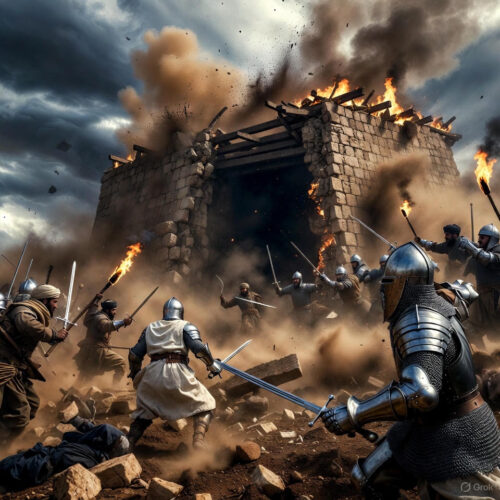
In the quiet aftermath of history’s tempests, Acre’s siege whispers strategies for our modern fortresses—the unseen battles against burnout, doubt, and disruption. The outcome? A total Mamluk victory that shattered Crusader illusions, forcing a reckoning with limits and legacies. But from that rubble, we glean timeless tactics: preparation averts panic, unity amplifies strength, and even in collapse, grace preserves the seed of renewal. Here’s how you, in the rush of 2025’s digital deluges and personal tempests, can wield these lessons to fortify your life, turning potential falls into platforms for ascent.
– **Embrace Foresight as Your First Moat**: Beaujeu’s spies and warnings echo today’s need for vigilance. Scan your “horizons” weekly—track career shifts via industry newsletters, monitor health with quarterly check-ins. This isn’t paranoia; it’s the difference between a breached wall and a reinforced gate. Apply it by auditing one vulnerability monthly: Is your savings buffer against job flux? Your skillset against AI’s advance? One Acre defender’s ignored omen cost thousands; your proactive pivot could save your trajectory.
– **Forge Alliances in the Face of Isolation**: The Templars and Hospitallers, rivals in peacetime, locked shields in crisis—a model for networking beyond silos. In your life, curate a “siege council”: three mentors for wisdom, two peers for accountability, one wildcard for fresh fire. Meet bi-monthly, not for coffee, but strategy sessions. When burnout besieges, their crossfire scatters the shadows; studies show social ties boost resilience by 50%, much like Acre’s polyglot defense held longer than solo stands.
– **Master Resource Discipline Amid Bombardment**: Famine in Acre taught rationing’s ruthlessness—prioritizing arrows over indulgences. Translate to finances: Adopt a “mangonel budget,” allocating 50% to essentials, 30% to growth (courses, tools), 20% to buffers. Track via apps like Mint, trimming “naphtha wastes” like impulse buys. Or in time: Block “Black Oxen” distractions—social scrolls—with Pomodoro bursts, reclaiming hours for deep work. This alchemy turns scarcity into surplus, echoing how Acre’s sea lanes sustained the siege.
– **Cultivate Inner Steel Through Ritual Rehearsal**: The knights’ daily drills—sword forms at dawn, prayers at vespers—built muscle memory for mayhem. Build yours with micro-rituals: Five-minute breathwork to steel against stress spikes, journaling “battle logs” to autopsy setbacks. When doubt mines your foundations, this rehearsed resolve collapses the tunnel before it widens. Neuroplasticity backs it: Consistent practice rewires brains for grit, turning potential routs into rallies.
– **Harvest Grace from the Breach**: Even as walls fell, survivors salvaged relics and sailed on—proof that loss isn’t erasure. In personal collapses—layoffs, heartbreaks—extract “salvage”: List three takeaways, then pivot. A failed venture yields contacts; a breakup, self-clarity. This Mamluk mercy in defeat sows tomorrow’s harvest, as Acre’s exiles seeded Cyprus’s renaissance.
To operationalize this, here’s a 90-day “Rampart Rebuild Plan”—a structured siege against stagnation, phased like Khalil’s assault but flipped for victory:
- **Days 1-30: Scout and Shore Up (Preparation Phase)**: Map your vulnerabilities—journal three “incoming threats” (e.g., skill gaps, relational rifts). Build your council: Reach out to five allies with specific asks. Stockpile: Audit resources, cut one drain, add one builder (book, habit). Milestone: A one-page “defense blueprint” outlining contingencies.
- **Days 31-60: Drill and Deflect (Endurance Phase)**: Rehearse daily—10 minutes of ritual (meditation, skill drill). Test alliances with a group challenge, like co-reviewing goals. Bombardment sim: Intentionally stress-test one area (e.g., pitch a bold idea), debriefing wins/losses. Milestone: Visible fortification, like a promoted skill or mended tie.
- **Days 61-90: Breach and Bloom (Renewal Phase)**: Face a deliberate “mine”—tackle a feared task head-on. Harvest: Document graces gained. Expand: Share your blueprint with your council, inviting input. Milestone: A “victory vigil”—celebrate with a ritual meal, toasting the new ramparts.
This isn’t abstract heroism; it’s Acre’s grit, distilled for your commute, cubicle, or quiet doubts. The siege ended an age, but its embers ignite ours—proving that true strongholds aren’t stone, but the unquenchable will to rebuild.
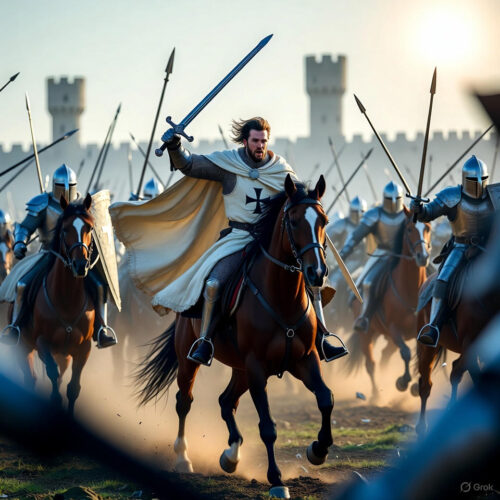
The echoes don’t fade there. As Acre’s dust settled, Khalil razed its fortifications, sowing salt in the earth—a psychological scar to deter return. Yet nature rebelled; vines crept back, olive groves whispered of rebirth. European chroniclers, from Joinville’s memoirs to Froissart’s chronicles, wove the tale into legend, inspiring troubadours who sang of “Acre’s Agony” in Provençal courts. Art immortalized it: Dominique Papety’s 1840 canvas in Versailles’ Hall of Crusades shows knights plummeting from towers, a romanticized frenzy of valor. Archaeology unearths it still—excavations since 2000 by the Israel Antiquities Authority reveal arrowheads fused in vitrified sand, mass graves with Frankish spurs tangled in Mamluk mail.
Deeper into the human tapestry: Consider the unsung. A Genoese crossbowman, perhaps like the anonymous “Pietro of Savona” in notarial rolls, who loosed 500 bolts before a naphtha pot claimed him—his precision a testament to immigrant grit. Or the Armenian merchants, buffers between camps, smuggling messages in olive jars, their bilingual savvy a bridge over enmity. Women, too: Eschiva d’Ibelin’s diplomacy at Sidon spared lives, a queenly echo of Eleanor of Aquitaine’s earlier valor. And the enslaved— Circassian Mamluks rising from chains to command, a meritocracy born of brutality that outlasted dynasties.
Theological undercurrents swirled. For Muslims, victory affirmed jihad’s arc, with Khalil commissioning the *Fath al-Malik al-Mu’ayyad* (Victory of the Victorious King), a panegyric praising Allah’s favor. For Christians, it spurred mysticism—St. Bridget of Sweden’s visions decried the loss as divine rebuke for greed. Politically, it realigned powers: Cyprus’s Lusignans schemed reconquests till 1474, while Aragon’s Peter III eyed Tunisia instead. Economically, the vacuum boosted Black Sea trade, funneling Genoese galleys to Caffa, unwittingly seeding the 1347 plague.
Yet the motivational marrow lies in adaptation’s alchemy. Acre’s fall forced the orders to reinvent: Templars pioneered letters of credit across Europe, birthing modern banking; Hospitallers honed naval warfare, precursors to today’s humanitarian fleets. In your life, this translates to pivoting post-“fall”—a job loss birthing entrepreneurship, a routine shattered yielding reinvention. It’s fun to imagine: Channel Beaujeu’s beard-stroking resolve in your next negotiation, or Khalil’s relentless prep in your side hustle grind. Educational? Dive into primary sources like the *Templar of Tyre* chronicle, a firsthand ledger of logistics and laments. Motivational? Remember: They held against oblivion; you can hold against Monday.

Extending the lens, Acre’s legacy threads through time’s weave. In 1516, Ottoman Selim I, Khalil’s distant heir, captured it anew, dubbing it “Akka Pasha.” Napoleon besieged it in 1799, foiled by Pasha Jazzar and British Admiral Sidney Smith—irony’s revenge, with 3,000 French dead to disease alone. Lawrence of Arabia’s 1918 dash liberated it from Turks, a Crusader redux. Today, UNESCO-listed Akko thrives as a dive site for medieval wrecks, its khans hosting falafel feasts where Jews, Arabs, and tourists toast uneasy peace.
But back to you: Those bullets aren’t platitudes; they’re Acre-engineered. Foresight? Qalawun’s 1289 Tripoli blueprint prepped Khalil—your weekly scans do the same. Alliances? The podestàs’ bickering nearly doomed Acre; your council averts solo sieges. Resources? Siege rolls show Templars melting church bells for shot—repurpose your “idles” similarly. Steel? Knights’ vigils mirrored monastic discipline; your rituals forge the same. Grace? Exiles carried the Grail legend onward; your takeaways propel you.
The plan’s phases mirror the siege’s arc: Scout like early April’s watches, drill through May’s barrages, bloom in evacuation’s wake. Track progress in a “chronicler’s log”—weekly entries, Acre-style. By day 90, you’ll stand taller, walls thicker, not against sultans, but subtler foes: procrastination’s sappers, envy’s mangonels. Fun twist: Gamify it—earn “Beaujeu badges” for drills, host “council feasts” with medieval mead (or mocktails).
History’s not dusty tomes; it’s dynamite for the soul. Acre fell, but its roar endures, urging: Build boldly, stand fiercely, rise resiliently. In 1291’s thunder, hear your call to arms.
